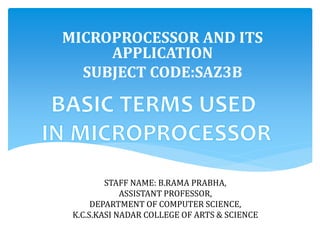
Microprocessor and Its Applications
- 1. STAFF NAME: B.RAMA PRABHA, ASSISTANT PROFESSOR, DEPARTMENT OF COMPUTER SCIENCE, K.C.S.KASI NADAR COLLEGE OF ARTS & SCIENCE MICROPROCESSOR AND ITS APPLICATION SUBJECT CODE:SAZ3B
- 2. Unit 1: Introduction to microcomputers-microprocessor and assembly languages- microprocessor architecture and its operations-8085 MPU-8085 instruction set and classifications Unit 2: Writing assembly level programs-programming techniques such as looping-counting and indexing addressing modes-data transfer instructions- arithmetic and log ic operations-dynamic debugging Unit 3: Counters and time delays-hexadecimal counter modulo 10 counter-pulse timings for flashing lights-debugging counter and time delay program-stack- subroutine-conditional call and return instructions SYALLABUS
- 3. Unit 4: BCD to binary and binary to BCD conversions-BCD to HEX and HEX to BCD conversions-ASCII to BCD to ASCII conversions-BCD to seven segment LED code conversions-binary to ASCII and ASCII to binary conversions-multi byte addition-multi byte subtraction-BCD addition-BCD subtraction-multiplication and division Unit 5: Interrupt-implementing interrupts-multiple interrupt 8085-trap-problems on implementing 8085 interrupt-DMA memory interfaces-RAM & ROM –I/O interface- direct I/O memory mapped I/O. SYLLABUS(contd…)
- 4. SOFTWARE: A Software is a set of programs, which is designed to perform a well-defined function. A program is a sequence of instructions written to solve a particular problem. BASIC TERMS USED IN MICROPROCESSOR
- 5. Hardware represents the physical and tangible components of a computer, i.e. the components that can be seen and touched. Examples of Hardware are the following − Input devices − keyboard, mouse, etc. Output devices − printer, monitor, etc. Secondary storage devices − Hard disk, CD, DVD, etc. Internal components − CPU, motherboard, RAM, etc. HARDWARE
- 6. DATA BIT : A bit (short for binary digit) is the smallest unit of data in a computer. A bit has a Single binary value, either 0 or 1. NIBBLE : A group of 4 bits is called nibble. (Eg:1011) BYTE : A group of 8 bits is called byte. A byte is the smallest unit, which can represent a data item or a character. (Eg:10111100)
- 7. DATA WORD : A computer word, like a byte, is a group of fixed number of bits processed as a unit, which varies from computer to computer but is fixed for each computer. WORD SIZE: The length of a computer word is called word-size or word length. It may be as small as 8 bits or may be as long as 96 bits. A computer stores the information in the form of computer words.
- 8. MEMORY A memory is just like a human brain. It is used to store data and instructions. Computer memory is the storage space in the computer, where data is to be processed and instructions required for processing are stored. The memory is divided into large number of small parts called cells. Each location or cell has a unique address, which varies from zero to memory size minus one.
- 11. Machine Language is a low-level language and it is coming under 1st generation languages. • Machine language uses only the symbols ‘0’ and ‘1’. • Machine language is a Low-level language. • This is the only language computer can understand directly. MACHINE LANGUAGE
- 12. Assembly language is also a low-level language and it is coming under 2nd generation Languages. -Assembly language uses Mnemonic codes in place of 0s and 1s. -Mnemonic is an abbreviation of a binary instruction. ASSEMBLY LANGUAGE
- 13. Third generation languages also called as High-level languages. • Programs are written in English like manner. • As this language is close to English programmers finds it easy to learn and use. • A language translator is required to convert high-level language programs. • Examples: C, C++, Java, BASIC, Pascal, FORTRAN, etc. HIGHLEVEL LANGUAGES
- 14. 4GL are called as very high level languages. • They have user-friendly interfaces. • They are easier than high-level languages. • They are very close to English language structure. • Examples: APL, CSP, Power Builder, Access. VERY HIGH LEVEL LANGUAGES
- 15. • 5GL closely resemble to human speech. • 5GL designed to make the computer solve a problem without a program written by programmer. • Fifth Generation languages are used in Artificial Intelligence research. Examples: LISP (List processing), PROLOG 5TH GENERATION LANGUAGES
- 16. Since computer only understands binary codes, 0 and 1, all programs written in any other language need to be translated to machine language before execution. There are three types of translator programs. THEY ARE: Assembler Compiler. Interpreter. TRANSLATOR
- 17. ASSEMBLER: Assembler is a system software which translates assembly language to machine language. INTERPRETER: Interpreter is a system software which translates high-level languages to machine language. Interpreter translates and executes the programs line-by-line. COMPILER: Compiler is a system software which translates high level language programs to machine language. Compiler translates the whole program first and then start executing the program.
- 18. Bus is a group of conducting wires which carries information, all the peripherals are connected to microprocessor through Bus. BUS
- 19. • Every microprocessor has a certain set of instructions that it is capable of executing. • This group of instructions is referred to as its instruction set. • Each type of microprocessor will have its own instruction set it can interpret and executive. Instruction Set